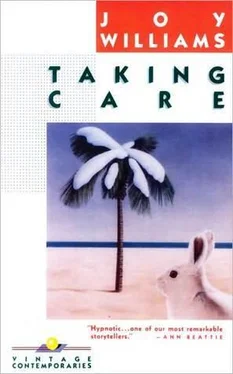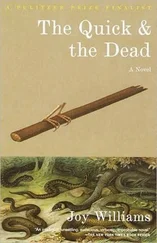Joy Williams - Taking Care
Здесь есть возможность читать онлайн «Joy Williams - Taking Care» весь текст электронной книги совершенно бесплатно (целиком полную версию без сокращений). В некоторых случаях можно слушать аудио, скачать через торрент в формате fb2 и присутствует краткое содержание. Год выпуска: 2010, Издательство: Vintage, Жанр: Современная проза, на английском языке. Описание произведения, (предисловие) а так же отзывы посетителей доступны на портале библиотеки ЛибКат.
- Название:Taking Care
- Автор:
- Издательство:Vintage
- Жанр:
- Год:2010
- ISBN:нет данных
- Рейтинг книги:5 / 5. Голосов: 1
-
Избранное:Добавить в избранное
- Отзывы:
-
Ваша оценка:
- 100
- 1
- 2
- 3
- 4
- 5
Taking Care: краткое содержание, описание и аннотация
Предлагаем к чтению аннотацию, описание, краткое содержание или предисловие (зависит от того, что написал сам автор книги «Taking Care»). Если вы не нашли необходимую информацию о книге — напишите в комментариях, мы постараемся отыскать её.
Taking Care — читать онлайн бесплатно полную книгу (весь текст) целиком
Ниже представлен текст книги, разбитый по страницам. Система сохранения места последней прочитанной страницы, позволяет с удобством читать онлайн бесплатно книгу «Taking Care», без необходимости каждый раз заново искать на чём Вы остановились. Поставьте закладку, и сможете в любой момент перейти на страницу, на которой закончили чтение.
Интервал:
Закладка:
The yard boy goes downstairs. He gives the plover to his landlady. She seems delighted. She puts it on a shelf in the pantry, just above the pie plates. The landlady has white hair, a wen, and old legs that end in sneakers. She wants the yard boy to look at a plant she has just bought. It is in a big green plastic pot in the sunshine of her kitchen. Nothing is more obvious than the hidden, the yard boy thinks.
“This plant is insane,” the yard boy says.
The landlady is shocked. She backs off a little from the plant which is a rabbit’s-foot fern.
“It has seen something terrible,” the yard boy says.
“I bought it on sale,” the landlady says. “At that place where I always go.”
The yard boy shakes his head. The plant waves a wrinkly leaf and drops it.
“Insane?” the landlady asks. She would like to cry. She has no family, no one.
“Mad as a hatter,” the yard boy says.
The restaurant that the yard boy’s girl friend chooses is not expensive. It is a fish restaurant. The plates are plastic. There is a bottle of tabasco sauce on each table. The girl friend doesn’t at all like fancy food, although she doesn’t mind accepting a bowl of chowder and a few glasses of wine.
A few booths over, a middle-aged couple are having an argument. They both have sunburns and wear white skirts and Haitian shirts. The argument seems to be about monograms. They are both yelling and one woman picks up a handful of oyster crackers and flings it into the other woman’s face. The oyster crackers stick all over the woman’s damp, sunburned face. The yard boy knows he should be satisfied with whatever situation arises but he is having a little difficulty with his enlightenment.
The yard boy’s girl friend is not talking to him. She has not been talking to him for days actually.
The woman that has been hit with the handful of oyster crackers walks past, an oyster cracker bobbing on her widow’s peak.
The yard boy miserably eats his pompano. When they are finished, his girl friend goes to the cashier for some toothpicks. While she is gone, another girl comes up with a baby.
“Would you watch my baby for me while I go to the ladies’?” she asks.
The yard boy holds the baby. The girl leaves. The yard boy’s girl friend returns. They don’t talk about the baby or anything. The girl friend sighs and crosses her legs. An hour passes. The restaurant is about to close. The yard boy and his girl friend and the baby are the last patrons. There is no one in the ladies’. The yard boy calls the manager and the manager calls the police. The baby chortles and spits up a little, not much. The police let the girl friend go first, and a few hours later they let the yard boy go.
The yard boy gets into his truck and drives off.
Life and the world are merely the dance of illusion, the yard boy thinks. He smells baby on his sweater.
The yard boy’s landlady has put her rabbit’s-foot fern out by the garbage cans. The yard boy picks it up and puts it in the cab of his truck. It goes wherever he goes now.
The yard boy gets a note from his girl friend. It says:
My ego is too healthy for real involvement with you. I don’t like you. Good-by.
Alyce
The yard boy works for Mr. Crown who is an illustrator. Mr. Crown lives in a fine house on the bay. Across the street, someone is building an even finer house on the Gulf. Mr. Crown was once the most renowned illustrator of Western art in the country. In his studio he has George Custer’s jacket. Sometimes the yard boy poses for Mr. Crown. The year before, a gentleman in Cody, Wyoming, bought Mr. Crown’s painting of an Indian who was the yard boy for fifty thousand dollars. This year, however, Mr. Crown is not doing so well. He has been reduced to illustrating children’s books. His star is falling. Also, the construction across the street infuriates him. The new house will block off his view of the sun as the sun slides daily into the water.
Mr. Crown’s publishers have told him that they are not interested in cowboys. There have been too many cowboys for too long.
The yard boy is spraying against scale and sooty mold.
“I don’t need the money but I am insulted,” Mr. Crown tells the yard boy.
Mr. Crown goes back into the house. The yard boy seeds some rye on the lawn’s bare spots and then takes a break to get a drink of water. He sits in the cab of his truck and drinks from a plastic jug. He sprinkles some water on the rabbit’s-foot fern. The fern sits there on the seat, dribbling a little vermiculite, crazy as hell.
The fern and the yard boy sit.
It is not a peaceful spot to sit. The racket of the construction on the Gulf is considerable. Nonetheless, the yard boy swallows his water and attempts to dwell upon the dignity and simplicity of the moment.
Then there is the sound of gunfire. The yard boy cranes his neck out of the window of his pickup truck and sees Mr. Crown firing from his studio at the workers across the street. It takes the workers several moments to realize that they are being shot at. The bullets make big mealy holes in the concrete. The bullets whine through the windows that will exhibit the sunset. The workers all give a howl and try to find cover. The yard boy curls up behind the wheel of his truck. The little rushy brown hairs on the fern’s stalks stick straight out.
A few minutes later the firing stops. Mr. Crown goes back to the drawing board. No one is hurt. Mr. Crown is arrested and posts twenty-five thousand dollars bond. Charges are later dropped. The house across the street is built. Still, Mr. Crown seems calmer now. He gives up illustrating. When he wants to look at something, he looks at the bay. He tells the yard boy he is putting sunsets behind him.
The yard boy and the rabbit’s-foot fern drive from lawn to lawn in the course of their days, the fern tipping forward a little in its green pot, the wind folding back its leaves. In the wind, its leaves curl back like the lips of a Doberman pinscher.
The yard boy sees things in the course of his work that he wouldn’t dream of telling the fern even though the fern is his only confidant. The fern has a lot of space around it in which anything can happen but it doesn’t have much of an emotional life because it is insane. Therefore, it makes a good confidant.
The yard boy has always been open. He has always let be and disowned. Nevertheless, he has lost the spontaneity of his awakened state. He is sad. He can feel it. The fern can feel it too which makes it gloomier than ever. Even so, the fern has grown quite fond of the yard boy. It wants to help him any way it can.
The yard boy doesn’t rent a room any more. He lives in his truck. Then he sells his truck. He and the rabbit’s-foot fern sit on the beach. The fern lives in the shade of the yard boy. The yard boy doesn’t live in the Now at all any more. He lives in the past. He thinks of his childhood. As a child he had a comic-book-collection high of three hundred and seventy-four with perfect covers. His parents had loved him. His parents had another son whom they loved too. One morning this son had fallen out of a tree onto the driveway and played with nothing but a spoon and saucepan for the next twenty-five years. When the yard boy has lived in the past as much as is reliable, he lives in the future. It is while he is living in the future that his girl friend walks by on the beach. She is walking by in a long wet T-shirt that says I’M NOT A TOURIST I LIVE HERE. The rabbit’s-foot fern alerts the yard boy and they both stare at her as she walks by.
It is a beautiful day. The water is a smooth green, broken occasionally by porpoises rising. Between the yard boy and his girl friend is sand a little less white than the clouds. Behind the yard boy are plantings of cabbage palms and succulents and Spanish bayonets. The bayonets are harsh and green with spikes that end in black tips like stilettos.
Читать дальшеИнтервал:
Закладка:
Похожие книги на «Taking Care»
Представляем Вашему вниманию похожие книги на «Taking Care» списком для выбора. Мы отобрали схожую по названию и смыслу литературу в надежде предоставить читателям больше вариантов отыскать новые, интересные, ещё непрочитанные произведения.
Обсуждение, отзывы о книге «Taking Care» и просто собственные мнения читателей. Оставьте ваши комментарии, напишите, что Вы думаете о произведении, его смысле или главных героях. Укажите что конкретно понравилось, а что нет, и почему Вы так считаете.












